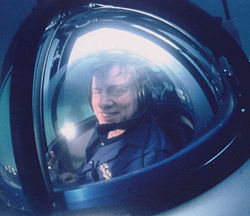"... but the movie'd make swillions!"
 The following review came out in the June 29, 2007, issue of DIVER and it's by Phil Nuytten, the magazine's senior editor and the guy who invented the Newtsuit. Being busy with life, I missed the review. Also, it was three years since the release of The Moon Pool, so I really wasn't looking for it. But, I stumbled across the review yesterday on the Web, so here it is.
The following review came out in the June 29, 2007, issue of DIVER and it's by Phil Nuytten, the magazine's senior editor and the guy who invented the Newtsuit. Being busy with life, I missed the review. Also, it was three years since the release of The Moon Pool, so I really wasn't looking for it. But, I stumbled across the review yesterday on the Web, so here it is.The review isn't all gravy. Nuytten calls MP an "obvious piece of pulp fiction" (ouch!) and takes exception to some of technical stuff. Still, it's a good, honest review. And he seems to like it. Besides, who could argue with Phil Nuytten?
First, the hype from the publisher:
“Time is running out for Jolene. She’s trapped, naked, waiting only for her worst nightmares to become reality. Her captor is keeping her alive for twenty-eight days, hidden in an underwater city 400 feet below the surface. Then she will die horribly – like the others….”
‘Moon Pool’ takes its hat off and waves it at the Thomas Harris international best-seller “Silence of the Lambs” for premise and character types. It hallucinates in somewhat the manner of Carlos Castenada’s efforts and has bits reminiscent of Carl Hiassen or Elmore Leonard’s Florida-based master-trashies. It combines some off the wall humor with genuine cave-diving expertise, leading some to conjecture that author McCoy might have been influenced, or even partially corrupted by Cavin’-Maven Wes Skiles! (Ah, the wonderful pomposity of multiple literary references!)
Max McCoy is the award-winning author of nine books prior to ‘Moon Pool’. He’s a skilled, professional writer with a good handle on craft as well as style. There are a lot of ingredients in the Moon Pool omelette, but he deals with them in a deft manner. The long and short of it that this novel is well written. As I said, the guy is a pro. Like any good artist or composer, he knows exactly where to leave spaces that the readers can color in for themselves. Consider this piece of dialogue as the giant cavern’s topside supervisor talks to the French pilot of a mini-submersible called ‘Water Baby’:
“Bonjour”
“Welcome to the good earth,” McAfee said in French. “It is December fourteenth, the time is sixteen forty Zulu, and the temperature is always seventeen degrees. It’s wet here, but it never rains. We thought you might like to start with an orientation tour of
McAfee listened for a moment.
"But of course. Red or white?"
No biggie, but a good example. There’s also a dash of Robert Heinlein, or perhaps it’s more
McCoy knows that the standard sub design is a problem and, I’ll be darned if he doesn’t use it as a plot device! The pressure diff is critical to the story’s whirlwind ending: will it hold? Or will it ‘blow up good’ and atomize the hero and the shapely young thing that he has just untied from the railroad tracks? We thought our guy’d had it for sure a couple of times, but the author plucked him out of harm’s way with a couple of artful dodges, but this time… well, odds are that he and the naked lady ( yep, she’s nekkid as a new-born chick!) who he’s in the midst of salvaging, have truly had the biscuit! I mean, com’on. There’s no way they’re going to get out of this one… how can they?
Read the book.
P.S. If someone doesn’t make this puppy into a movie, they’re missing a bet. Think ‘Sea Hunt’, ‘American Pyscho’ and ‘Survivor’ mixing it up in ‘The Cave’ – whilst a bevy of nekkid, red-headed beauties arranged in Busby
I don't know exactly what a swillion is, but I'd like to find out. Now, go buy a subscription to DIVER!



<< Home